Oyster mushrooms are large, oyster-shell-shaped edible fungi species. Their chewy, flavorful, fruiting bodies are widely popular in Chinese, Japanese and Korean cuisine. It is native to the dense forests of North America, Northern Europe, and Siberian Asia.
Botanically, they belong to the family: Pleurotaceae, and the genus: Pleurotus.
| Oyster mushrooms Quick Facts | |
|---|---|
| Name: | Oyster mushrooms |
| Scientific Name: | Pleurotus ostreatus |
| Origin | It was firstly sophisticated in Germany during World War I. It is grown economically in the world as food. |
| Colors | White-gray or tan-dark brown (Cap) |
| Shapes | Convex and semicircular; Width: 1-12 inches, Thickness: 1/2-1 ½ inches (Cap) |
| Flesh colors | White, firm, thick |
| Taste | Mild-strong |
| Calories | 28 Kcal./cup |
| Major nutrients | Vitamin D (166.67%) Vitamin B3 (26.64%) Copper (23.33%) Vitamin B2 (23.08%) Vitamin B5 (22.26%) |
| Health benefits | Maintain blood sugar, Immunity system, Cardiovascular conditions, Skin problems, Brain health |
Oyster mushroom is an edible mushroom which was originated in Germany during World War I. Pleurotus ostreatus is commonly known as Oyster Shelf, Tree Oyster, Tamogitake, and Straw Mushroom is a mushroom very similar to Pleurotus pulmonarius with some differences. The cap of the Oyster mushroom is broad and fan or oyster shape. Pleurotus ostreatus prefer temperate and sub-tropical climates. This fungus grows on dead hardwood trees.
Oyster mushrooms Scientific Classification
Scientific Name: Pleurotus ostreatus
| Rank | Scientific Name & (Common Name) |
|---|---|
| Kingdom | Fungi |
| Division | Basidiomycota |
| Order | Agaricales |
| Family | Pleurotaceae |
| Genus | Pleurotus |
| Species | P. ostreatus |
| Synonyms |
|
Oyster Mushrooms are found on deciduous trees such as willows and occasionally on pines. The mushrooms are fleshy, gray, white or brown. The caps are eight inches in width in a semi-circle shape. It has feathery gills which are yellowish or white. Besides live trees, it grows on the fallen branches or stumps.
| Name | Oyster mushrooms |
|---|---|
| Scientific Name | Pleurotus ostreatus |
| Common/English Name | Oyster Shelf, Tree Oyster, Tamogitake and Straw Mushroom |
| Plant Growth Habit | On dead hardwood trees |
| Growing Climate | Temperate and sub-tropical |
| Stem | Nearly absent |
| Cap shape and size | Broad, fan or oyster shape, convex and semicircular; Width: 1-12 inches, Thickness: 1/2-1 ½ inches |
| Cap color | White-gray or tan-dark brown |
| Gills | White-cream |
| Spore print | White-lilac gray |
| Flesh color | White, firm, thick |
| Taste | Mild-strong |
| Major Nutritions (Raw) | Vitamin D (Cholecalciferol) 25 µg (166.67%) Vitamin B3 (Niacin) 4.262 mg (26.64%) Copper, Cu 0.21 mg (23.33%) Vitamin B2 (Riboflavin) 0.3 mg (23.08%) Vitamin B5 (Pantothenic acid) 1.113 mg (22.26%) Phosphorus, P 103 mg (14.71%) Iron, Fe 1.14 mg (14.25%) Vitamin B1 (Thiamin) 0.108 mg (9.00%) Vitamin B9 (Folate) 33 µg (8.25%) Tryptophan 0.036 g (8.18%) |
| Health Benefits |
|
| Calories in 1 cup sliced (86 gm) | 28 Kcal. |
| Precautions |
|
| How to Eat |
|
History
It was firstly sophisticated in Germany during the World War I. It is grown economically in the world as a food. It is cultivated as similar to the king Oyster mushroom. These mushrooms are also used for industrial purposes. These fungi are cultivated worldwide generally in the India, South East Asia, Africa and Europe.
In the 18th century, Joseph Freiherr von Jacquin assigned the Oyster mushrooms in the Agarius family due to the presence of gills underneath the cap. In 1871, Paul Kummar, a German mucologist assigned the mushroom in Pleurotus family. Germany grew Oyster mushroom during World War I as a necessity food which discovered the antibiotic qualities of this mushroom.
Plant
The cap of Oyster mushrooms are broad, fan or oyster shape, convex and semicircular; 1-12 inches as a width and 1/2-1 ½ inches thick. The cap is white-gray or tan-dark brown in color. The gills are white to cream color. The spore print is white-liliac gray. It has white, firm and thick flesh.
Nutritional value of Mushrooms, oyster, raw
Calories 28 Kcal. Calories from Fat 3.15 Kcal.
| Proximity | Amount | % DV |
|---|---|---|
| Water | 76.69 g | N/D |
| Energy | 28 Kcal | N/D |
| Energy | 120 kJ | N/D |
| Protein | 2.85 g | 5.70% |
| Total Fat (lipid) | 0.35 g | 1.00% |
| Ash | 0.87 g | N/D |
| Carbohydrate | 5.24 g | 4.03% |
| Total dietary Fiber | 2 g | 5.26% |
| Total Sugars | 0.95 g | N/D |
| Glucose (dextrose) | 0.95 g | N/D |
| Minerals | Amount | % DV |
|---|---|---|
| Calcium, Ca | 3 mg | 0.30% |
| Iron, Fe | 1.14 mg | 14.25% |
| Magnesium, Mg | 15 mg | 3.57% |
| Phosphorus, P | 103 mg | 14.71% |
| Potassium, K | 361 mg | 7.68% |
| Sodium, Na | 15 mg | 1.00% |
| Zinc, Zn | 0.66 mg | 6.00% |
| Copper, Cu | 0.21 mg | 23.33% |
| Manganese, Mn | 0.097 mg | 4.22% |
| Selenium, Se | 2.2 µg | 4.00% |
| Vitamins | Amount | % DV |
|---|---|---|
| Water-soluble Vitamins | ||
| Vitamin B1 (Thiamin) | 0.108 mg | 9.00% |
| Vitamin B2 (Riboflavin) | 0.3 mg | 23.08% |
| Vitamin B3 (Niacin) | 4.262 mg | 26.64% |
| Vitamin B5 (Pantothenic acid) | 1.113 mg | 22.26% |
| Vitamin B6 (Pyridoxine) | 0.095 mg | 7.31% |
| Vitamin B9 (Folate) | 33 µg | 8.25% |
| Folic Acid | 0 µg | N/D |
| Folate, food | 33 µg | N/D |
| Folate, DEF | 33 µg | N/D |
| Choline | 41.9 mg | 7.62% |
| Fat-soluble Vitamins | ||
| Vitamin A, RAE | 2 µg | 0.29% |
| Vitamin A, IU | 41 IU | N/D |
| Beta Carotene | 25 µg | N/D |
| Betaine | 10.4 mg | N/D |
| Vitamin D (Cholecalciferol) | 25 µg | 166.67% |
| Vitamin D (D2 + D3) | 0.6 µg | N/D |
| Vitamin D2 (ergocalciferol) | 0.6 µg | N/D |
| Lipids | Amount | % DV |
|---|---|---|
| Fatty acids, total saturated | 0.053 g | N/D |
| Palmitic acid 16:00 (Hexadecanoic acid) | 0.053 g | N/D |
| Fatty acids, total monounsaturated | 0.027 g | N/D |
| Oleic acid 18:1 (octadecenoic acid) | 0.027 g | N/D |
| Fatty acids, total polyunsaturated | 0.106 g | N/D |
| Linoleic acid 18:2 (octadecadienoic acid) | 0.106 g | N/D |
| Campesterol | 1 mg | N/D |
| Amino acids | Amount | % DV |
|---|---|---|
| Tryptophan | 0.036 g | 8.18% |
| Threonine | 0.12 g | 6.82% |
| Isoleucine | 0.096 g | 5.74% |
| Leucine | 0.144 g | 3.90% |
| Lysine | 0.108 g | 3.23% |
| Methionine | 0.036 g | N/D |
| Cystine | 0.024 g | N/D |
| Phenylalanine | 0.096 g | N/D |
| Tyrosine | 0.072 g | N/D |
| Valine | 0.169 g | 8.00% |
| Arginine | 0.157 g | N/D |
| Histidine | 0.06 g | 4.87% |
| Alanine | 0.206 g | N/D |
| Aspartic acid | 0.254 g | N/D |
| Glutamic acid | 0.544 g | N/D |
| Glycine | 0.108 g | N/D |
| Proline | 0.036 g | N/D |
| Serine | 0.108 g | N/D |
*Above mentioned Percent Daily Values (%DVs) are based on 2,000 calorie diet intake. Daily values (DVs) may be different depending upon your daily calorie needs. Mentioned values are recommended by a U.S. Department of Agriculture. They are not rxharun.com recommendations. Calculations are based on average age of 19 to 50 years and weighs 194 lbs. Source: https://ndb.nal.usda.gov/
Health Benefits of Oyster mushroom
Oyster mushrooms are mostly found in Chinese foods. Due to its high amount of nutrients, it is widely popular. Oyster mushroom is sautéed with garlic and olive oil. They are loaded with various amounts of nutrients and vitamins which makes them a healthy diet. It is free from fat, cholesterol, gluten, low in calories and sodium. The iron found in Oyster mushrooms is high in comparison to the meat.
- Maintain the levels of blood sugar
The insufficient amount of insulin in the body results in diabetes. Calcium is required for insulin secretion. Vitamin D helps to reduce inflammation and raise insulin sensitivity. The studies show that Vitamin D helps to prevent both type 1 and type 2 diabetes.
- Immunity system
Vitamin D helps to replicate the healthy cells and protects the autoimmune conditions such as flu and the common cold. It also prevents excessive or prolonged inflammatory responses. Inflammation is the cause for autoimmune disorders and chronic diseases such as rheumatoid arthritis, multiple sclerosis, irritable bowel syndrome, high blood pressure and digestive problems.
- Cardiovascular conditions
Besides the balance of triglycerides and cholesterol levels, Vitamin B3 helps to reduce atherosclerosis that is the hardening of arteries which may lead to heart disease. It also assists to reduce histamine production and inflammation along with the improvement in circulation.
Vitamin B3 reduces the chances of reoccurring heart disease or cardiac arrest in those who have already experienced it it. Additionally, Vitamin B3 helps to treat pellagra which is a health condition that occurs from the deficiency of niacin.
- Skin problems
Vitamin B3 which is in the form of niacinamide helps to clear acne when it is applied topically in the skin. Niacin assists in the reduction of flare-ups, skin inflammation, redness, and irritation. It also helps to treat granuloma annual are and bullous pemphigoid which is a skin disease that blisters the skin, causes pain and infection.
- Brain health
The studies show that copper has an impact on the brain pathways such as galactose and dopamine which helps to maintain the energy, mood, focus and outlook. The deficiency of copper results in fatigue, low metabolic activity, poor mood, and problems in concentration. Copper also helps to utilize the antioxidants such as superoxide dismutase, Vitamin C, tyrosinase, and ascorbate oxidase. This helps to prevent the damage made by free radicals in the brain and also slows down the process of ageing, neurodegenerative diseases and cancer.
- Cures anemia
An inadequate amount of oxygen in the blood, low red bloods cell production and the blood loss are the causes of Anemia. Vitamin B2 helps to prevent anemia. Vitamin B2 is vital for the production of red blood cells and steroid hormone synthesis. It assists in transporting the oxygen in the body and also mobilizes iron. People with low Vitamin B2 have a high chance of sickle cell anemia and anemia. The research shows that Vitamin B2 helps to reduce the homocysteine levels in the blood.
- Provides energy
Vitamin B converts the carbohydrate into glucose which is used as a fuel to produce energy. Vitamin B synthesizes the body and metabolizes proteins and fats. Vitamin B5 assist to rebuild muscles, tissues, and organs. Vitamin B5 helps to maintain the optimum level of metabolism.
- Prevents tooth decay
Vitamin D, phosphorus, and calcium help to form and maintain dental health by assisting the jaw-bone mineral density, holding the teeth and tooth enamel. Children need calcium and phosphorus-rich foods to develop adult teeth and form the hard structure of teeth. Vitamin D requires phosphorus to balance the calcium and enhance absorption while forming teeth. Vitamin D reduces gum inflammation which is related to periodontal gum disease.
- Maintains mood
Neurotransmitter functions depend on the adequate amount of iron to maintain a positive mood. It also depends on the hormone balance such as dopamine, serotonin, and others. So the deficiency of iron leads to bad sleep, poor mood, lack of motivation, and low level of energy.
- Alcoholism
Vitamin B1 assist to reduce the chances of a brain disorder named Wernicke-Korsakoff Syndrome which includes nerve damage, muscle movement, problem in walking, and lethargy. It is caused due to low thiamine and poor diet but is usually seen in alcoholics. A high intake of thiamine can reduce the symptoms of alcohol withdrawal.
Types of Oyster Mushroom
Some types of Oyster mushroom are listed below:
1. Golden Oyster Mushroom (Pleurotus citrinopileatus)
 Golden oyster mushroom has a distinct taste with delightful light yellow color. This mushroom is hypersensitive and low in productivity rate.
Golden oyster mushroom has a distinct taste with delightful light yellow color. This mushroom is hypersensitive and low in productivity rate.
2. Pleurotus cornucopiae
 The cap is cream-colored during young and turns yellowish to ochraceous when matured. The cap is funnel-shaped with white inner flesh that is white and mild taste.
The cap is cream-colored during young and turns yellowish to ochraceous when matured. The cap is funnel-shaped with white inner flesh that is white and mild taste.
3. Pink Oyster Mushroom (Pleurotus djamor)
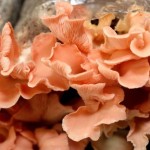 It is native to tropical and subtropical areas which have an exotic look. This mushroom has a color similar to the color of salmon flesh. In addition, it is thermo tolerant and is cultivated in warm weather.
It is native to tropical and subtropical areas which have an exotic look. This mushroom has a color similar to the color of salmon flesh. In addition, it is thermo tolerant and is cultivated in warm weather.
4. Pleurotus eryngii (King Oyster Mushroom)
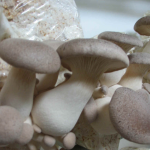 It is easy to grow and has a therapeutical utility, less productive in comparison to other types of Oyster mushrooms. In addition, It promotes nutritive supplements same as rye grains or wheat.
It is easy to grow and has a therapeutical utility, less productive in comparison to other types of Oyster mushrooms. In addition, It promotes nutritive supplements same as rye grains or wheat.
5. Pleurotus ostreatus (Oyster Mushroom)
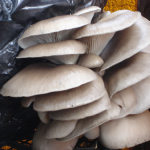 It was originated from the Greek word pleura which means side and otus which means ear. It is simple to be grown and various productive strains are found. It could be cultivated in any season. It progresses well in low temperatures or high temperatures.
It was originated from the Greek word pleura which means side and otus which means ear. It is simple to be grown and various productive strains are found. It could be cultivated in any season. It progresses well in low temperatures or high temperatures.
6. The Florida Oyster Mushroom (Pleurotus florida)
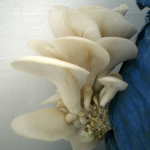 This mushroom was originated in Florida. It is suitable to be grown in moist and warm weather. It is used traditionally all around the world.
This mushroom was originated in Florida. It is suitable to be grown in moist and warm weather. It is used traditionally all around the world.
7. Indian Oyster or Phoenix Mushroom (Pleurotus pulmonarius)
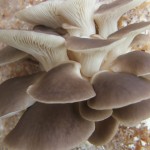 This mushroom has the shape and color of human lungs. It consists of varieties such as var. lapponicus, var. juglandis and var. pulmonarius. Juglandis are found on Juglans spp. trees whereas others grow on the hardwoods as well as conifers beyond subtropical and temperate areas.
This mushroom has the shape and color of human lungs. It consists of varieties such as var. lapponicus, var. juglandis and var. pulmonarius. Juglandis are found on Juglans spp. trees whereas others grow on the hardwoods as well as conifers beyond subtropical and temperate areas.
Additional Health Benefits of Oyster mushrooms
- P. ostreatus is one of the very low-calorie mushrooms. 100 grams of fresh fungus carries just 33 calories. Nonetheless, this flavorful fungus is loaded with natural bioactive compounds, antioxidants, minerals, and vitamins that promote health.
- Oyster mushroom contains an HMG-CoA reductase enzyme inhibitor substance called statin (lovastatin or Mevinolin-2.8% dry weight).
- They compose β-glucan which has anti-viral and anti-allergic properties.
- Certain protein polysaccharides in the oyster mushroom have been found to have anti-hyperglycemic, anti-soft tissue tumor, immunomodulatory, anti-inflammatory, antihypertensive effects in experimental animal studies.
- In traditional Chinese medicine (TCM), the oyster fungus is known to dispel cold wind, relax tendons and bones and strengthen yang. It is indicated to treat impotence, weakness of joints and limbs, and backache problems.
- Oyster mushrooms carry relatively high amounts of good quality protein than other cultivated mushrooms.
- Fresh mushroom is an excellent source of folic acid (38 μg 9.5% per 100 g).
- Further, they contain ample concentrations of another B-complex group of vitamins like thiamin, riboflavin, niacin, pantothenic acid, pyridoxine, etc.
- Minerals such as copper, iron, phosphorus are present in moderate levels in this mushroom.
- Oyster mushrooms are modest sources of vitamin-D (ergo-calciferol) at 29 μg per 100 g (7% of DA). Vitamin D plays a vital role in calcium and phosphate metabolism.
Selection and storage
Fresh and dried oyster mushrooms can be readily available in US supermarkets. Choose non-slimy and evenly colored oyster mushrooms with a smooth cap and no black spots. Pleurotus mushrooms are highly perishable and absorb the flavor of surrounding foods. Consume them immediately.
They also sold dried and in brine in these stores.
For storage, place them in a paper bag or in a dish covered with cloth for a short period (2-3 days). Dried oyster in sealed packs and vacuum packs can stay well for many months.
Preparation and serving methods
Fresh oyster mushrooms do not require washing. Just clean any surface dirt or sand particle using a soft brush. You can tear the ears (caps) by hand since they cook evenly in the dishes because of the uniform thickness of caps.
Oyster mushrooms impart mild mushroomy flavor and distinct fleshy texture in the dishes. Thus, they can be an ideal substitute in the dishes that call for pork or poultry. Do not mask their flavor by pairing them with strongly flavored foods or cooking them in a large amount of butter or oil. They can be sautéed or boiled for 3-5 min, quick braised, or baked for 7-10 min. Their stems require a longer cooking time and benefit from being chopped evenly.
In mainland China, oyster mushrooms are usually stir-fried with complementing vegetables as a side dish.
Here are some serving tips:
- They are also delicious braised, sauteed, marinated, or grilled.
- They can be simply enjoyed sauteed in garlic oil or butter.
- They are added to soups and sauces and work well with rice, pasta dishes, eggs, tofu, poultry, and seafood.
- Finely sliced oyster mushrooms can also be added in pizza, pasta, and potpie preparations.
Best Recipes to Cook Those Oyster Mushrooms
These mushrooms are loaded with nutrition such as vitamins and minerals. Here are some of the recipes that help to understand the preparation of Oyster mushrooms.
1. Short And Simple, The Mushroom Soup
It is one of the best methods to use mushrooms in a soup. The mushrooms should be boiled and mixed in a mixer. The oil should be added to the pan and include the ingredients. Add butter as well as salt to a soup. The veggies could be added to make it more healthy.
2. Quick and Easy Tacos
It is a simple way to use Oysters. Take a pack of tacos and a few vegetables with oyster mushrooms such as carrots, cheese, bell peppers, and broccoli. Cut all the veggies into small pieces. Add little butter in a pan and then sauté vegetables. Then add pepper and salt to the vegetables for a taste. Let it become cool. Now take tacos and add the mix to tacos. Then serve.
How to Use Oyster Mushrooms
Oyster mushrooms could be added to stir fry or sauté in olive oil and garlic. It is the best replacement for portobello and button mushrooms. Oyster mushrooms enhance the taste of soups and sauces.
The supplements of Oyster mushrooms could be found in the form of supplements. It could be taken in capsule form. It provides the same effect on cholesterol and also enhances an immune system. Two capsules in a day provide 200 mg of Oyster mushroom when it is taken along with a full glass of water or meal.
References